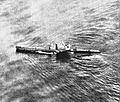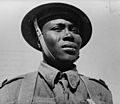Free France facts for kids
Free France and its Free French Forces (French: France Libre and Forces françaises libres) were the government-in-exile led by Charles de Gaulle during the Second World War and its military forces that continued to fight against the Axis powers as one of the Allies after the fall of France. It was set up in London in June 1940 and also organised and supported the Resistance in occupied France.
Charles de Gaulle, a French government minister who rejected the armistice concluded by Marshal Philippe Pétain and who had escaped to Britain, exhorted the French to resist in his BBC broadcast "Appeal of 18 June" (Appel du 18 juin), which had a stirring effect on morale throughout France and its colonies, although initially relatively few French forces responded to de Gaulle's call.
On 27 October 1940, the Empire Defense Council (Conseil de défense de l'Empire) was constituted to organise the rule of the territories in central Africa, Asia and Oceania that had heeded the 18 June call. It was replaced on 24 September 1941 by the French National Committee (Comité national français or CNF). On 13 July 1942, "Free France" was officially renamed France combattante ("Fighting France"), to mark that the struggle against the Axis was conducted both externally by the FFF and internally by the French Forces of the Interior (FFI). After the reconquest of North Africa, this was in turn formally merged with de Gaulle's rival general Henri Giraud's command in Algiers to form the French Committee of National Liberation (Comité français de Libération nationale or CFNL). Exile officially ended with the capture of Paris by the 2nd Armoured Free French Division and Resistance forces on 25 August 1944, ushering in the Provisional Government of the French Republic (gouvernement provisoire de la République française or GPRF). It ruled France until the end of the war and afterwards to 1946, when the Fourth Republic was established, thus ending the series of interim regimes that had succeeded the Third Republic after its fall in 1940.
The Free French fought Axis and Vichy regime troops and served on battlefronts everywhere from the Middle East to Indochina and North Africa. The Free French Navy operated as an auxiliary force to the Royal Navy and, in the North Atlantic, to the Royal Canadian Navy. Free French units also served in the Royal Air Force, Soviet Air Force, and British SAS, before larger commands were established directly under the control of the government-in-exile.
From colonial outposts in Africa, India, and the Pacific, Free France steadily took over more and more Vichy possessions, until after the Allied landings in North Africa (Operation Torch) in November 1942 Vichy only ruled over the zone libre in southern France and a few possessions in the West Indies (and nominally over Japanese-occupied French Indochina). The French Army of Africa switched allegiance to Free France, and this caused the Axis to occupy Vichy in reaction.
On 1 August 1943, L'Armée d'Afrique was formally united with the Free French Forces to form L'Armée française de la Liberation. By mid-1944, the forces of this army numbered more than 400,000, and they participated in the Normandy landings and the invasion of southern France, eventually leading the drive on Paris. Soon they were fighting in Alsace, the Alps and Brittany, and by the end of the war in Europe, they were 1,300,000 strong – the fourth-largest Allied army in Europe – and took part in the Allied advance through France and invasion of Germany. The Free French government re-established a provisional republic after the liberation, preparing the ground for the Fourth Republic in 1946.
Images for kids
-
Charles de Gaulle was an armoured division commander and a minister in the Reynaud government during the Battle of France.
-
In Occupied France during the war, reproductions of the 18 June appeal were distributed through underground means as pamphlets and plastered on walls as posters by supporters of the Résistance. This could be a dangerous activity.
-
Emile Fayolle, pilot of the Free French Air Force, during the Battle of Britain
-
A very modern Dunkerque-class battleship commissioned in 1937, Strasbourg was potentially a quite substantial threat to British control of the sealanes were she to fall into Axis hands.
-
Insigna of the Free French Forces in the Far East (French Indochina), Langlade Mission
-
The fall of Damascus to the Allies, late June 1941. A car carrying Free French commanders General Georges Catroux and General Paul Louis Le Gentilhomme enters the city, escorted by French Circassian cavalry (Gardes Tcherkess).
-
The FFF's tenacious defence at Bir Hakeim prevented Rommel's attempted flanking manoeuvre at El Alamein from succeeding.
-
Operation Torch landings in Morocco and Algeria
-
Henri Giraud and de Gaulle during the Casablanca Conference in January 1943. Churchill and Roosevelt are in the background.
-
FAFL Normandie-Niemen Yak-3 preserved at the Paris Le Bourget museum
-
Charles de Gaulle speaks as president of interim government to the population of Cherbourg from the city hall's balcony on 20 August 1944
-
The Western Front in 1944
-
Leclerc's 2nd Armoured Division (2e DB) parading down the Champs Elysées on 26 August 1944, the day after the Liberation of Paris
-
A plaque commemorating the Oath of Kufra in near the cathedral of Strasbourg
See also
 In Spanish: Francia Libre para niños
In Spanish: Francia Libre para niños




















